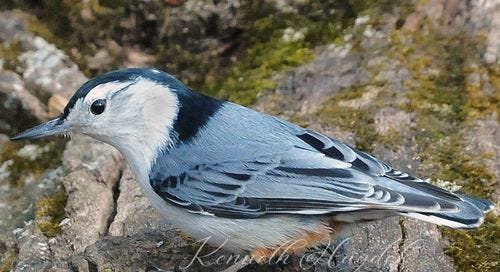What's WBNU to you?
What do you know about the white-breasted nuthatch (WBNU)? Could you pick one out of a group of birds hanging around your feeder?
March: The White-Breasted Nuthatch
We begin our monthly electronic birding expeditions with this little fella: the white-breasted nuthatch (WBNU for short). If you live in the United States, there’s a good chance you’ve seen him around in your backyard, in parks, at the edge of forested areas, or in any grove of leafy trees, like oaks, hickories, and maples.
How will you know when you see one? The picture above shows the male: capped with black, blue-gray on his back, a frosty-white face and belly, and a blush of rust color on his underside toward the rear. The ladies look similar but don softer gray caps on their heads. White-breasted nuthatches have straight pointy bills, short tails, and no necks.
White-breasted nuthatches do not migrate, so you can be on the lookout for them year-round. They’re little birds (so be attentive!), about five inches tall, with a wingspan of seven to ten inches, and weighing around an ounce or less.
The male and female white-breasted nuthatches usually mate for life and stick together in the same nesting territory all year. They produce one brood of five to nine eggs each year, making nests in hollow spots or old woodpecker holes.
Insects and spiders are the white-breasted nuthatches’ favorite food in the summer months. In the winter months when bugs are scarcer, their diet includes more seeds and nuts, which they gather and store for later in tree-bark crevices. Their signature move is to perch upside down on a tree trunk or large branch and walk along in a vertical manner. They use their pointy bills to get at nuts and acorns they’ve hidden in the bark grooves.
White-breasted nuthatches are feeder birds and will eat the seeds, suet, and even peanuts that you put out in your bird feeder. But white-breasted nuthatches are cautious little critters—they are more likely to arrive at your feeder (together with their mates) if they can join a flock of chickadees or titmice. If you don’t see them, you may recognize their presence by their nasal call.
Sources:
https://www.audubon.org/field-guide/bird/white-breasted-nuthatch
https://www.allaboutbirds.org/guide/White-breasted_Nuthatch/overview
https://www.allaboutbirds.org/guide/White-breasted_Nuthatch/id



